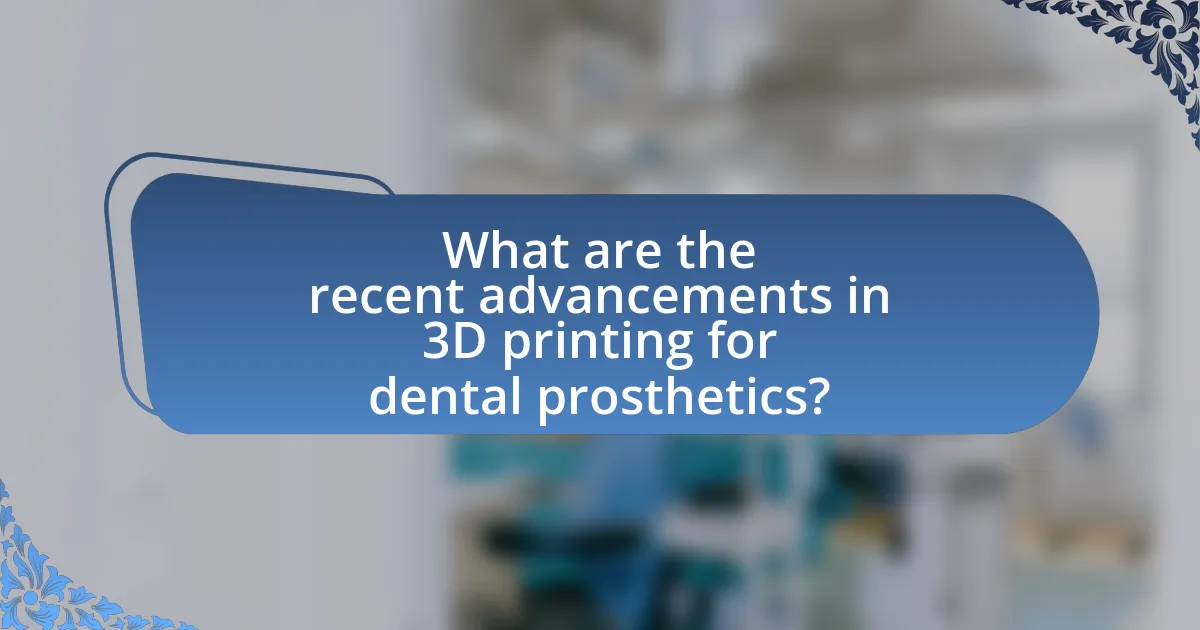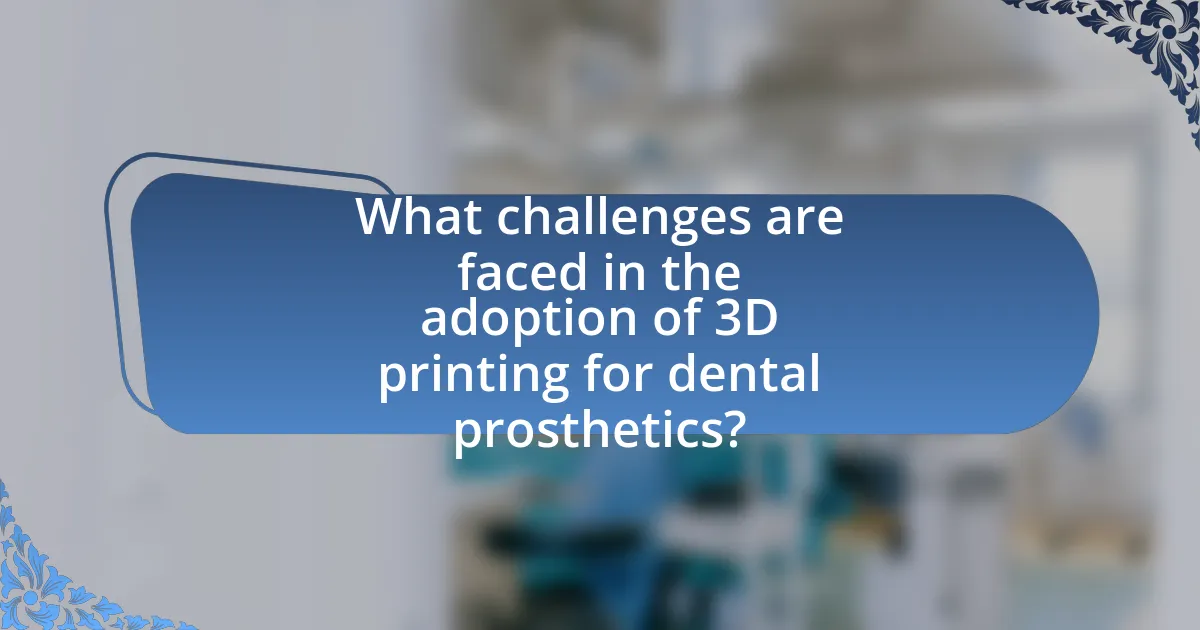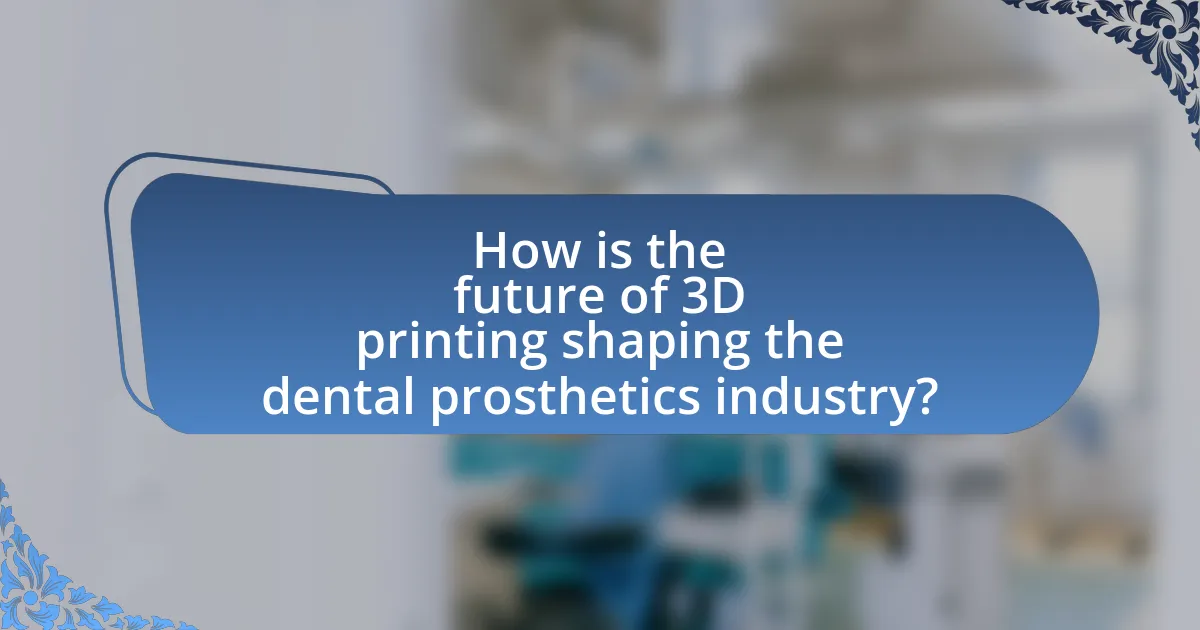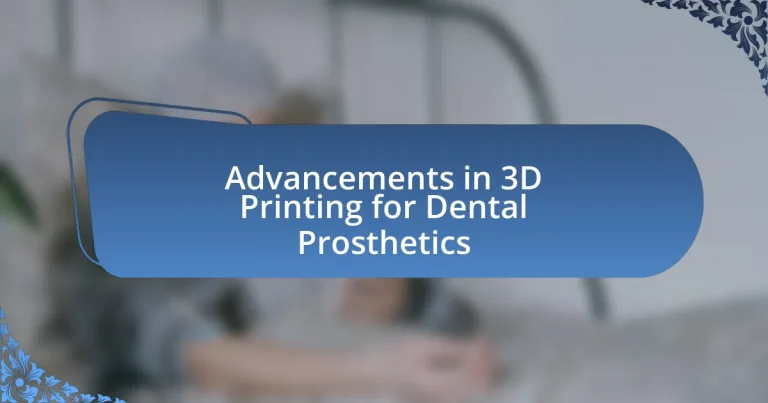The article focuses on recent advancements in 3D printing technology specifically for dental prosthetics. It highlights the development of biocompatible materials and improved printing techniques that enhance precision, speed, and customization of dental devices such as crowns, bridges, and dentures. Key topics include the evolution of technology in dental applications, the introduction of new materials that improve quality and durability, the benefits of 3D printing in terms of cost savings and patient outcomes, and the challenges faced in regulatory compliance and technical limitations. Additionally, the article discusses emerging trends, including the integration of artificial intelligence and the importance of patient-specific solutions in shaping the future of dental prosthetics.

What are the recent advancements in 3D printing for dental prosthetics?
Recent advancements in 3D printing for dental prosthetics include the development of biocompatible materials and improved printing technologies that enhance precision and speed. Innovations such as the use of resin-based materials allow for the creation of highly detailed and durable dental crowns, bridges, and dentures. For instance, a study published in the Journal of Prosthetic Dentistry in 2022 demonstrated that new photopolymer resins significantly reduce printing time while maintaining high accuracy, achieving a dimensional tolerance of less than 50 microns. Additionally, advancements in multi-material printing enable the production of prosthetics with varying properties, such as flexibility and strength, tailored to specific patient needs. These improvements not only streamline the manufacturing process but also enhance patient outcomes by providing more comfortable and aesthetically pleasing dental solutions.
How has technology evolved in 3D printing for dental applications?
Technology in 3D printing for dental applications has evolved significantly, transitioning from basic prototyping to advanced, precise manufacturing of dental prosthetics. Initially, 3D printing in dentistry primarily focused on creating models for surgical planning and educational purposes. However, advancements in materials and printing techniques, such as the introduction of biocompatible resins and high-resolution printers, have enabled the production of functional dental devices like crowns, bridges, and aligners.
For instance, the use of digital workflows, including intraoral scanning and computer-aided design (CAD), has streamlined the process, allowing for faster turnaround times and improved accuracy. Research indicates that 3D-printed dental prosthetics can achieve a fit accuracy of up to 100 microns, which is comparable to traditional methods. Furthermore, the integration of artificial intelligence in design software has enhanced customization, enabling personalized treatment plans that cater to individual patient needs.
Overall, these technological advancements have not only improved the efficiency and precision of dental applications but have also reduced costs and increased accessibility for patients.
What new materials are being used in 3D printing for dental prosthetics?
New materials being used in 3D printing for dental prosthetics include biocompatible resins, such as those based on methacrylate and polyether ether ketone (PEEK). These materials offer improved mechanical properties and aesthetic qualities, making them suitable for creating durable and visually appealing dental restorations. For instance, methacrylate-based resins provide excellent adhesion and can be used for crowns and bridges, while PEEK is known for its strength and resistance to wear, making it ideal for frameworks in removable prosthetics. Recent studies have shown that these materials enhance the longevity and functionality of dental prosthetics, thereby improving patient outcomes.
How do these materials improve the quality of dental prosthetics?
Advanced materials used in 3D printing significantly enhance the quality of dental prosthetics by providing superior strength, durability, and biocompatibility. These materials, such as high-performance polymers and ceramics, allow for precise customization and a better fit, which reduces the risk of complications and improves patient comfort. For instance, studies have shown that materials like polyether ether ketone (PEEK) exhibit excellent mechanical properties and resistance to wear, making them ideal for long-lasting dental applications. Additionally, advancements in resin formulations have led to improved aesthetic outcomes, closely mimicking the appearance of natural teeth.
What are the key benefits of using 3D printing in dental prosthetics?
The key benefits of using 3D printing in dental prosthetics include enhanced customization, reduced production time, and cost-effectiveness. Enhanced customization allows for precise fitting of dental prosthetics to individual patient anatomy, improving comfort and functionality. Reduced production time is achieved through rapid prototyping, enabling quicker turnaround from design to final product, which is crucial in dental practices. Cost-effectiveness arises from the reduction in material waste and the ability to produce complex designs without the need for expensive molds or tooling. These benefits collectively contribute to improved patient outcomes and increased efficiency in dental practices.
How does 3D printing enhance customization for dental patients?
3D printing enhances customization for dental patients by enabling the production of highly personalized dental prosthetics tailored to individual anatomical needs. This technology allows for precise measurements and designs based on 3D scans of a patient’s mouth, resulting in restorations that fit better and function more effectively. Studies have shown that 3D-printed dental devices, such as crowns and aligners, can be produced with a high degree of accuracy, often within microns, which significantly improves patient comfort and satisfaction. Additionally, the rapid prototyping capabilities of 3D printing reduce the time required to create custom dental solutions, allowing for quicker treatment turnaround.
What cost savings can be achieved through 3D printing in dentistry?
3D printing in dentistry can achieve cost savings of up to 50% compared to traditional methods. This reduction in costs primarily stems from decreased material waste, as 3D printing utilizes only the necessary amount of material for each dental prosthetic. Additionally, the speed of production allows for quicker turnaround times, reducing labor costs and overhead associated with longer manufacturing processes. A study published in the Journal of Prosthetic Dentistry found that 3D printing not only lowers the cost of materials but also minimizes the need for multiple appointments, further enhancing efficiency and reducing overall patient costs.

What challenges are faced in the adoption of 3D printing for dental prosthetics?
The challenges faced in the adoption of 3D printing for dental prosthetics include regulatory hurdles, material limitations, and the need for skilled personnel. Regulatory hurdles arise from the necessity for compliance with health and safety standards, which can delay the approval process for new materials and technologies. Material limitations refer to the current lack of biocompatible and durable materials that can withstand the demands of dental applications. Additionally, the requirement for skilled personnel to operate advanced 3D printing technologies and interpret digital designs presents a barrier, as there is a shortage of trained professionals in the field. These challenges collectively hinder the widespread implementation of 3D printing in dental practices.
What regulatory hurdles exist for 3D printed dental devices?
Regulatory hurdles for 3D printed dental devices include compliance with FDA regulations, ensuring biocompatibility, and meeting quality control standards. The FDA classifies dental devices based on risk, requiring premarket notification or approval for certain products, which can delay market entry. Additionally, manufacturers must demonstrate that materials used in 3D printing are safe for oral use, as outlined in ISO 10993 standards for biocompatibility. Quality control is also critical, as 3D printing processes must adhere to Good Manufacturing Practices (GMP) to ensure consistency and reliability in production. These regulatory requirements can complicate the development and commercialization of 3D printed dental devices.
How do regulations impact the development of new 3D printing technologies?
Regulations significantly influence the development of new 3D printing technologies by establishing safety, quality, and efficacy standards that must be met before products can enter the market. For instance, in the dental prosthetics sector, regulatory bodies like the FDA in the United States require rigorous testing and validation of materials and processes used in 3D printing to ensure patient safety and product reliability. This regulatory framework can accelerate innovation by providing clear guidelines for manufacturers, but it can also slow down the introduction of new technologies due to lengthy approval processes. Compliance with these regulations often necessitates substantial investment in research and development, which can deter smaller companies from entering the market. Thus, while regulations aim to protect consumers, they also shape the pace and direction of technological advancements in 3D printing for dental applications.
What are the implications of these regulations for dental practitioners?
The implications of these regulations for dental practitioners include the necessity to comply with updated standards for the use of 3D printing technologies in creating dental prosthetics. These regulations may require dental practitioners to undergo additional training to ensure they understand the legal and safety requirements associated with 3D printing processes. Furthermore, adherence to these regulations can enhance patient safety and product quality, as they often mandate rigorous testing and validation of materials used in 3D printing. Compliance can also affect the cost structure of dental practices, as practitioners may need to invest in new equipment or software to meet regulatory standards.
What technical limitations currently affect 3D printing in dentistry?
Technical limitations currently affecting 3D printing in dentistry include material constraints, resolution issues, and regulatory challenges. The materials used in dental 3D printing, such as resins and metals, often lack the necessary mechanical properties and biocompatibility required for long-term use in patients. Additionally, the resolution of some 3D printers may not meet the high precision needed for intricate dental applications, leading to inaccuracies in fit and function. Regulatory hurdles also pose challenges, as the approval processes for new materials and technologies can be lengthy and complex, hindering innovation and adoption in clinical settings.
How do precision and accuracy issues impact the effectiveness of dental prosthetics?
Precision and accuracy issues significantly impact the effectiveness of dental prosthetics by affecting fit, function, and patient satisfaction. When dental prosthetics are not precisely manufactured, they may not fit correctly, leading to discomfort, improper bite alignment, and potential damage to surrounding teeth. Studies have shown that inaccuracies in the fabrication process can result in a misfit rate of up to 30%, which directly correlates with increased patient complaints and the need for adjustments or remakes. Furthermore, precise measurements and accurate material properties are essential for ensuring the longevity and durability of prosthetics, as inaccuracies can lead to premature wear or failure. Thus, maintaining high standards of precision and accuracy in the production of dental prosthetics is crucial for their overall effectiveness and the well-being of patients.
What advancements are being made to overcome these technical limitations?
Advancements in 3D printing for dental prosthetics include the development of new materials, improved printing technologies, and enhanced software for design and simulation. For instance, biocompatible resins are being engineered to provide better strength and aesthetic qualities, addressing durability and appearance limitations. Additionally, advancements in multi-material printing allow for the creation of prosthetics with varying properties in a single print, improving functionality. Research from the Journal of Prosthetic Dentistry highlights that these innovations lead to faster production times and more precise fit, significantly reducing the time patients wait for their dental prosthetics.

How is the future of 3D printing shaping the dental prosthetics industry?
The future of 3D printing is significantly transforming the dental prosthetics industry by enabling rapid prototyping, customization, and cost reduction. This technology allows dental professionals to create highly accurate and personalized prosthetics, such as crowns, bridges, and dentures, tailored to individual patient anatomy. For instance, a study published in the Journal of Prosthetic Dentistry in 2021 demonstrated that 3D-printed dental prosthetics can achieve a fit accuracy of over 95%, which enhances patient satisfaction and reduces the need for adjustments. Additionally, 3D printing streamlines the production process, reducing manufacturing time from weeks to days, thereby improving overall efficiency in dental practices.
What emerging trends are influencing the future of 3D printing in dentistry?
Emerging trends influencing the future of 3D printing in dentistry include the integration of artificial intelligence, advancements in biocompatible materials, and the rise of personalized dental solutions. Artificial intelligence enhances design processes and optimizes printing parameters, leading to improved accuracy and efficiency in creating dental prosthetics. Advancements in biocompatible materials, such as resin and metal alloys, enable the production of durable and safe dental products. Additionally, the trend towards personalized dental solutions allows for customized implants and aligners tailored to individual patient needs, improving treatment outcomes and patient satisfaction. These trends are supported by ongoing research and development in the field, demonstrating a clear trajectory towards more innovative and effective dental practices.
How might artificial intelligence integrate with 3D printing for dental applications?
Artificial intelligence can integrate with 3D printing for dental applications by enhancing the design and manufacturing processes of dental prosthetics. AI algorithms can analyze patient data, including scans and images, to create highly customized and precise models for 3D printing. For instance, AI-driven software can optimize the geometry of dental implants or crowns, ensuring better fit and functionality. Additionally, machine learning techniques can predict material behavior during the printing process, leading to improved quality and reduced waste. Research has shown that AI integration can significantly decrease production time and increase the accuracy of dental prosthetics, ultimately improving patient outcomes.
What role will patient-specific solutions play in the future of dental prosthetics?
Patient-specific solutions will significantly enhance the future of dental prosthetics by enabling customized designs that improve fit, function, and aesthetics. These tailored solutions leverage advancements in 3D printing technology, allowing for precise replication of individual anatomical features, which leads to better patient outcomes. Research indicates that personalized prosthetics can reduce the need for adjustments and improve patient satisfaction, as evidenced by a study published in the Journal of Prosthetic Dentistry, which found that custom-fitted prosthetics resulted in a 30% increase in comfort and usability compared to standard options.
What best practices should dental professionals follow when implementing 3D printing?
Dental professionals should follow best practices such as ensuring high-quality materials, maintaining equipment regularly, and adhering to precise digital workflows when implementing 3D printing. High-quality materials, such as biocompatible resins, are essential for producing durable and safe dental prosthetics. Regular maintenance of 3D printers, including calibration and cleaning, ensures consistent print quality and reduces errors. Additionally, following a precise digital workflow, which includes accurate scanning, designing, and printing processes, enhances the overall efficiency and effectiveness of 3D printing in dental applications. These practices are supported by studies indicating that adherence to quality standards significantly improves patient outcomes and satisfaction in dental prosthetics.
How can dental practitioners ensure quality control in 3D printed prosthetics?
Dental practitioners can ensure quality control in 3D printed prosthetics by implementing standardized protocols for design, printing, and post-processing. These protocols include using validated software for accurate digital impressions, selecting high-quality materials that meet industry standards, and conducting regular calibration of 3D printers to maintain precision. Additionally, practitioners should perform thorough inspections of the printed prosthetics for dimensional accuracy and surface finish, utilizing tools such as calipers and 3D scanning technology for verification. Research indicates that adherence to these quality control measures significantly reduces the risk of errors and enhances the overall fit and function of dental prosthetics, thereby improving patient outcomes.
What are the recommended steps for integrating 3D printing into dental practices?
To integrate 3D printing into dental practices, the recommended steps include assessing the practice’s needs, selecting appropriate 3D printing technology, training staff, and establishing workflows. First, dental practices should evaluate their specific requirements, such as the types of prosthetics they intend to produce. Next, choosing the right 3D printing technology, such as stereolithography or fused deposition modeling, is crucial for meeting those needs. Training staff on the operation and maintenance of the 3D printers ensures effective use and minimizes errors. Finally, developing streamlined workflows that incorporate 3D printing into existing processes enhances efficiency and patient outcomes. These steps are supported by the growing trend of 3D printing in dentistry, which has been shown to reduce production time and costs while improving the accuracy of dental prosthetics.


